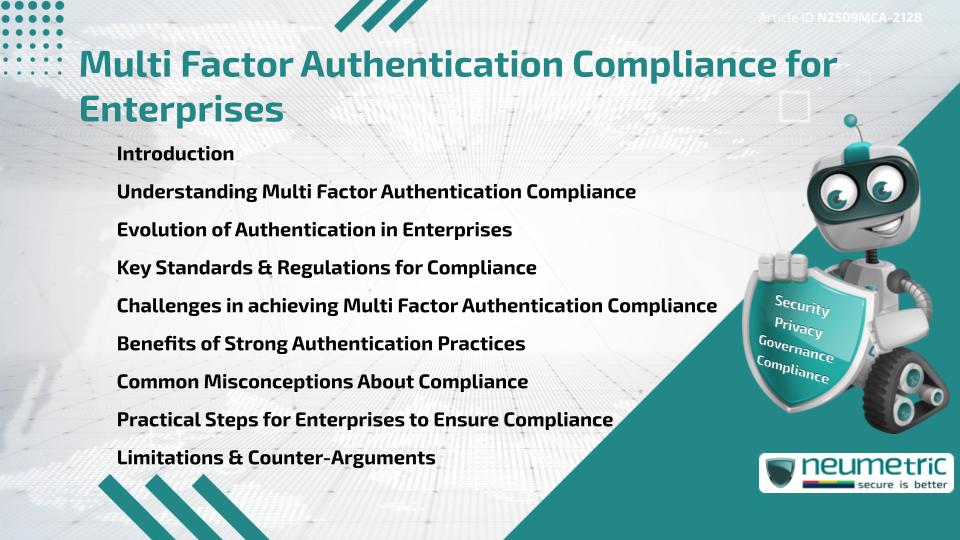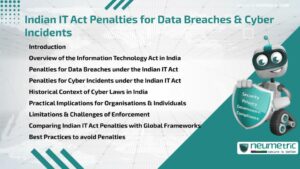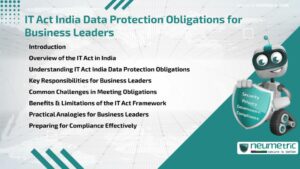Table of Contents
ToggleIntroduction
Multi factor authentication compliance has become a cornerstone of enterprise security. It requires organisations to implement additional verification methods beyond passwords to ensure secure access to sensitive Systems & Data. For enterprises, compliance is not just a regulatory box to tick but a practical defense against phishing, credential theft & data breaches. Standards such as PCI DSS, GDPR & NIST guidelines mandate strong authentication practices, making compliance essential for legal, operational & reputational security.
Understanding Multi Factor Authentication Compliance
Multi factor authentication compliance means enterprises must use at least two different categories of authentication factors: something the User knows (password), something the User has (smart card or token), and something the User is (biometric). This layered approach significantly reduces the Risk of unauthorised access. Compliance ensures that enterprises not only implement these methods but also align with specific laws & standards that govern secure access management.
Evolution of Authentication in Enterprises
Authentication in enterprises has evolved from simple passwords to advanced multi factor systems. In the early days of computing, single passwords were sufficient. However, as Cyber Threats grew, attackers exploited weak & reused passwords. The introduction of tokens, smart cards & biometric technologies created stronger defenses. Regulations soon followed, requiring enterprises to adopt multi factor authentication compliance as a mandatory safeguard for critical data & systems.
Key Standards & Regulations for Compliance
Several major standards guide enterprises in achieving multi factor authentication compliance:
- PCI DSS: Requires strong authentication for systems handling payment card data.
- GDPR: Mandates robust Access Controls for Personal Data in Europe.
- NIST SP 800-63B: Provides guidelines for digital identity management.
- ISO 27001: Encourages Risk-based authentication practices in Information Security management systems.
Each Framework emphasises the importance of multiple authentication factors to reduce Risks of unauthorised access.
Challenges in achieving Multi Factor Authentication Compliance
Enterprises often face challenges in implementing compliance. High costs of deploying multi factor technologies, resistance from Employees due to perceived inconvenience & integration difficulties with legacy systems create hurdles. Additionally, remote work & mobile device use expand the attack surface, making compliance even more complex.
Benefits of Strong Authentication Practices
Despite challenges, multi factor authentication compliance delivers strong benefits. It significantly reduces the Risk of breaches caused by stolen or weak passwords. Enterprises also improve regulatory alignment, avoiding penalties & legal liabilities. Strong authentication builds trust with customers, partners & regulators while fostering a culture of accountability within the organisation.
Common Misconceptions About Compliance
Some enterprises believe multi factor authentication compliance is optional or only applies to certain industries. In reality, many global regulations explicitly require it. Another misconception is that multi factor authentication makes systems completely immune to attacks. While it adds a strong layer of security, it must be combined with monitoring, encryption & Employee awareness for full effectiveness.
Practical Steps for Enterprises to Ensure Compliance
To achieve multi factor authentication compliance, enterprises can take the following steps:
- Assess systems & identify where multi factor authentication is required.
- Select appropriate authentication methods based on Risk levels.
- Educate Employees about why compliance matters & how to use authentication tools effectively.
- Integrate multi factor authentication with single sign-on for convenience.
- Continuously monitor & Audit authentication practices to ensure ongoing compliance.
These steps help enterprises strengthen security while aligning with regulations.
Limitations & Counter-Arguments
While multi factor authentication compliance is essential, it is not without limitations. Some argue that multi factor tools add friction to the User experience, potentially lowering productivity. Others highlight that determined attackers may still bypass authentication through advanced phishing or man-in-the-middle attacks. Therefore, compliance should be paired with broader Cybersecurity measures, not treated as a standalone solution.
Takeaways
- Multi factor authentication compliance protects enterprises from password-related breaches.
- Regulations such as PCI DSS, GDPR & NIST make strong authentication mandatory.
- Implementation challenges include costs, Employee resistance & system integration.
- Compliance improves trust, reduces Risks & ensures legal accountability.
- Multi factor authentication is a critical safeguard but not a complete solution by itself.
FAQ
What is multi factor authentication compliance?
It is the requirement for enterprises to implement authentication methods using at least two different factors to secure access to Systems & Data.
Why is multi factor authentication compliance important for enterprises?
It helps protect Sensitive Information, meet regulatory requirements & reduce Risks of cyberattacks.
Which regulations mandate multi factor authentication compliance?
Major standards include PCI DSS, GDPR, NIST SP 800-63B & ISO 27001.
What challenges do enterprises face in achieving compliance?
High costs, Employee resistance & integration with legacy systems are common issues.
Does multi factor authentication guarantee complete security?
No, while it greatly reduces Risks, it must be paired with other Cybersecurity measures to be fully effective.
How can enterprises simplify compliance for Employees?
By integrating multi factor authentication with single sign-on solutions & providing clear training.
What are the main benefits of multi factor authentication compliance?
It reduces Risks of breaches, avoids penalties, builds trust & strengthens enterprise security culture.
Need help for Security, Privacy, Governance & VAPT?
Neumetric provides organisations the necessary help to achieve their Cybersecurity, Compliance, Governance, Privacy, Certifications & Pentesting needs.
Organisations & Businesses, specifically those which provide SaaS & AI Solutions in the Fintech, BFSI & other regulated sectors, usually need a Cybersecurity Partner for meeting & maintaining the ongoing Security & Privacy needs & requirements of their Enterprise Clients & Privacy conscious Customers.
SOC 2, ISO 27001, ISO 42001, NIST, HIPAA, HECVAT, EU GDPR are some of the Frameworks that are served by Fusion – a SaaS, multimodular, multitenant, centralised, automated, Cybersecurity & Compliance Management system.
Neumetric also provides Expert Services for technical security which covers VAPT for Web Applications, APIs, iOS & Android Mobile Apps, Security Testing for AWS & other Cloud Environments & Cloud Infrastructure & other similar scopes.
Reach out to us by Email or filling out the Contact Form…





